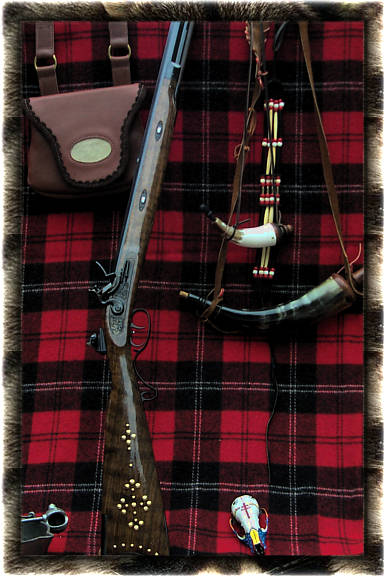|
I'll try to make my instructions easy to understand, but also as specific as possible.
How to Load a Muzzleloader
Step 1: Inspect the muzzleloader to ensure it s working properly. Make sure the half cock notch is working properly. Also
inspect the nipple or touch hole liner for wear. Both of these are termed high wear items as they will and do wear out. Also
if you have a flintlock this is when you check the flint for dullness. Once this is done take a cleaning patch saturated in
rubbing alcohol and wipe the frizzen face and the flint which removes any trace amounts of oil on these parts which will result
in misfires or hang fires. Now is also the time to check the barrel to make sure all is well there. Check for bulges in the
barrel, also check the breech area. This is where the breechplug joins or is threaded on the barrel. If there is a white ring
this indicates a gas leak in the breechplug and the rifle should not be fired in this condition but taken to a competent gunsmith
who deals with blackpowder firearms to have the problem corrected. If you get into the habit of checking for all these things
it becomes second nature and you learn your rifle quickly and will notice changes faster.

Step 2: Attach your cleaning jag to your ramrod. Now take a cleaning patch and run it down the bore (dry). This will remove
any excess lube out of your barrel leaving only a film.
Caplock shooters-Take your nipple wrench and remove the
nipple off your rifle. Take a pipe cleaner and run it through to clean out any possible oil that might have gotten into the
nipple and re-install it on the rifle.
Step 3: Now take your powder measure and set it to the desired setting. Most powder measurers will turn to tighten and loosen
although some just pull up and down as in a collapsible cup one might use in camping.
Step 4: Pour your powder into
the measure. Again I stress that you use ONLY blackpowder or a blackpowder substitute. Once I fill my measure I will take
the flask and lightly tap the side of the measure to help settle the powder and add more if needed. Never pour powder directly
from a can into the barrel. ALWAYS USE A MEASURER! Let's keep the sport safe.
Step 5: Pour the powder down the barrel.
Then turn the rifle lockside down (on inlines 1/4 turn so that the trigger instead of being down is now on the side) and give
the rifle a couple raps with your hand down towards the breech. This will help settle powder and make sure it falls down into
the breech.
Step 6: Now is the time to seat your projectile. If you are using roundballs take a patch and a roundball.
Lay the patch on top of the barrel and put the roundball on top. Take the ball starter and set it on top of the ball and give
it a good rap with your other hand. Once you get it started remove the short starter and use your ramrod to seat the roundball
all the way down the barrel till it comes to rest on top of the powder charge.
If you are using conicals. Take a
conical and you should be able to thumb push it down to get it slightly started. It will not completely start and be flush
with the bore as if you are using a maxi-ball or maxi-hunter type bullet the lower bands on the bullet are sub caliber with
the only part of the bullet being true caliber is just above the first lube ring. You can thumb start it to this point. Then
using your ramrod proceed to push the bullet down onto the powder charge. Once you establish your "pet load" or
load which has the best accuracy mark your ramrod. To do this take a pocket knife and lightly score the ramrod sitting on
top of the ball/bullet your just seated. Using this mark will tell you that your load is all the way down where it belongs
in the future if ever in doubt. The only thing is that if you ever change your load you have to change your mark. If you lightly
score it you can change easily. This mark could save your life. If you are ever in doubt that your projectile is down, DO
NOT FIRE. Stop, insert the ramrod and check the mark. To proceed shooting could bulge or possibly blow a barrel resulting
in injury or death to the shooter or bystanders.
For hunting purposes only Step 7: On sidelocks when you remove
the nipple to clean re-install it finger tight at this point. Load as above, once loaded, take the nipple back off the rifle
and in a well lit room or outside look down the hole. Make sure there is powder back there directly underneath the nipple.
If not put some there. Then re-install the nipple. (For plinking unless you just want to there is no need to do this.)
Step 8: Prime your weapon. For percussion install a cap on the nipple. For flint shooters put the priming powder in the
pan. Flint shooters should give the rifle a light rap on the opposite side of the lock to even out the powder. Close frizzen
on flinters.
Step 9: Fire your weapon after making sure of your target of course.
|




